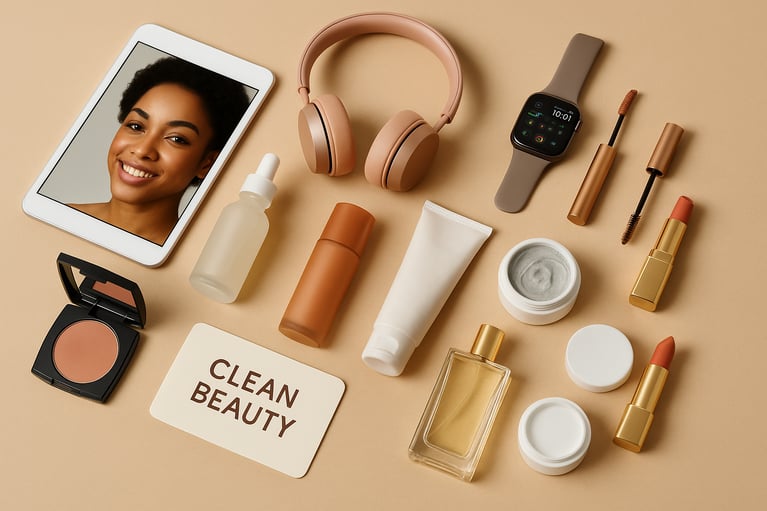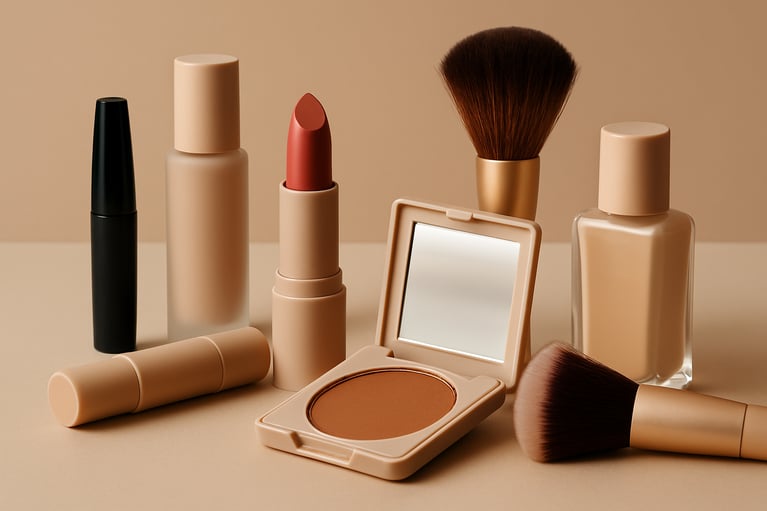The stratospheric rise of beauty ecommerce has opened the market to brands both large and small. According to McKinsey & Company, beauty industry ecommerce quadrupled between 2015 and 2022, with 22% of current beauty retail sales worldwide taking place online, the most of any sales channel.
2024 is shaping up to be another strong year, with the industry forecasted to grow at an annual rate of 3.33% and generate $646 billion. That said, the beauty industry is oversaturated, making it critical for brands to differentiate themselves from the crowd. It also makes it crucial to stay on top of notable up-and-coming beauty ecommerce trends.
This article will cover trends to watch this year in the beauty ecommerce industry and how you can leverage them to create brand awareness and drive growth.
What is beauty ecommerce?
Beauty ecommerce includes an expanding variety of products spanning categories such as skincare, makeup, fragrance and hair care. Digitally native businesses are driving beauty ecommerce growth, utilizing online and social platforms to sell.
With the hype that surrounds the beauty industry, consumers are constantly looking for products that address their pain points or are recommended by experts, influencers or celebrities. Because consumers in the beauty space are often eager to try something new, effective or trending, mastering customer loyalty can be challenging.
Additionally, beauty ecommerce comes with a unique set of issues. Unlike a brick-and-mortar retail setting, it’s harder for customers to get the whole sensory experience while shopping online. This makes it key for brands to create an immersive and exceptional customer experience ranging from discovery to post-purchase.
Understanding and implementing trends based on customer needs and desires can go a long way toward attracting and retaining customers and driving growth.
Top 2024 beauty ecommerce trends
This year is all about AI, the end-to-end customer experience, hyper-personalization, social selling and subscription boxes. However, sustainability and diversity and inclusion still draw mission-minded buyers. Here are the top trending strategies to consider for your beauty brand in 2024.
Creating an exceptional end-to-end customer experience
Customer preferences evolve and change, and people are more mindful of spending. In 2024, customers want a positive, memorable beauty buying experience. This means delighting, from pre-purchase to post-purchase. According to Salesforce, 88% of buyers say experience matters as much as a company’s products or services. And there are numerous touchpoints and opportunities to engage along the way.
You can improve and optimize each stage of the journey by analyzing your data, listening to customers and adapting to trends.
- Pre-purchase: During this stage, consumers are looking for information. They look to social media, a company website or reviews. In essence, they’re looking to content to answer their questions. It’s a stage that can’t be neglected or you risk losing interest. Beauty influencers and brand partnerships are tools that can boost your visibility.
- Consideration: This is where brands can begin to personalize. Begin to ask about their needs and individual issues. For example, an automated survey that asks questions about hair type, what they use on their hair, if their hair is colored and can point them toward products that best fit their needs. Beauty retailers can also use chat and other guided interfaces to provide recommendations.
- Purchase: Make purchase seamless, whether a customer is buying through a website, app or social platform. Offer a variety of payment methods and clearly outline your shipping times, costs and return policies.
- Post-purchase: The post-purchase experience has become as important as other stages. Not only is fast and free or low-cost shipping a demand, 46% of US consumers want relevant follow-up after their purchase. This includes when an item is shipped, real-time tracking and delivery confirmation. Another trending post-purchase experience is unboxing. Beauty brands can elevate awareness and create a memorable, emotional moment with the right packaging and extras. Your beauty ecommerce fulfillment strategy will be a crucial part of post-purchase success.
Leverage social channels
It’s no secret that social channels are an excellent tool for discovery and growth. However, it’s essential that you expand how you use them. Social platforms can be leveraged in multiple ways, starting with discovery. In a recent compilation of beauty ecommerce stats, 45% of US beauty shoppers recalled first hearing about items via social media. But what made those products stand out?
A brand’s social strategy is crucial in 2024, starting with exploring ways to gain awareness. Brand partnerships, beauty influencers and micro-influencers can help draw focus to your brand. Cohesive and unique campaigns and product features help you stand out. Storytelling and user-generated content spread the word. You can also employ new tactics, like social selling, making it easy to purchase on social platforms and hosting live shopping events, giveaways and contests.
Implement AI and AR
AI and AR trends empower beauty ecommerce brands to mimic in-store experiences in innovative ways. Brands not adopting the latest technology are missing out on opportunities. Some of the notable ways beauty retailers use AI and AR in 2024 include:
- “Trying on” with Augmented Reality (AR): New tools allow shoppers to try on colors and visualize how they look in different products.
- AI shopping assistants: Constructor, who showcased their new conversation product discovery tool at NRF 2024, demonstrated how the latest generative AI is helping make suggestions based on detailed requests from shoppers. Customers can now ask or request things like, “I want makeup for a night out,” or “What are the best hair products for curly hair?” and receive targeted recommendations.
- AI-powered product recommendation quizzes: Many retailers have implemented product recommendation quizzes. Consumers walk through a series of questions that help them find products that best meet their needs. With the help of AI, these quizzes have become more powerful than ever.
Adopt mission-driven initiatives
Consumer have become more conscientious. A Razorfish study found that 82% of respondents stated the brands they buy personally stand for a greater mission/purpose. They seek out companies that display inclusivity and want to see businesses use sustainable practices. Beauty ecommerce brands can adopt these habits in 2024 by showing more diversity, equity and inclusion, and investing in eco-friendly packaging and shipping.
Drive loyalty with programs and subscriptions
Ecommerce beauty brands can boost loyalty through personalized loyalty programs and subscriptions. Offer exclusive perks, early access to products and personalized recommendations to keep customers engaged.
Subscription boxes are another way to incentivize long-term commitment. Offer a recurring delivery of curated products based on customer preferences. Subscription boxes let buyers:
- Select a subscription plan: Customers choose a subscription plan based on their preferences (monthly, quarterly, annually).
- Autopay: Subscribers provide payment information, and they are billed automatically according to the chosen subscription interval.
- Experience unboxing: Customers receive their subscription box and enjoy the excitement of unboxing curated or personalized items.
- Give feedback or reviews: Some subscription box services encourage customers to provide feedback or reviews, helping to improve future selections.
- Easily renew or cancel: Subscriptions automatically renew unless the customer chooses to cancel. Customers have the flexibility to manage their subscription preferences.
Subscription boxes often focus on providing a variety of products or unique items, allowing customers to discover new brands or products they might not have tried otherwise.
Hyper-personalize
Hyper-personalization delivers the right message to the right customer at the right time. It’s about identifying where a customer is in the journey and creating personalized touchpoints. Beauty ecommerce retailers can use automation to remind customers that a product might be running low or send targeted promotions based on browsing and purchase history and their timing preference.
Why beauty ecommerce trends are essential for your 2024 strategies
Ecommerce beauty trends play a crucial role in shaping strategies. By understanding current beauty trends, brands can align their products and marketing with what consumers are looking for. This increases relevance and appeal to the target audience. Staying on the forefront of beauty ecommerce trends also allows brands to differentiate themselves from competitors. These trends drive:
- Innovation and product development: Ecommerce beauty trends often indicate shifts in consumer preferences and technological advancements. Brands can use this information to innovate their product offerings, introduce new formulations, ingredients or packaging that align with the latest trends.
- Effective marketing: Incorporating current beauty trends into marketing campaigns enhances their effectiveness. Trends generate buzz and interest, making it easier for brands to capture attention.
- Customer engagement: By aligning with popular beauty trends, ecommerce brands can foster stronger connections with their customers. Trend-driven products and marketing strategies demonstrate that the brand is attuned to customer preferences, leading to increased trust and loyalty.
- Adaptation to industry changes: The beauty industry evolves rapidly, influenced by factors such as social media, technology, economy and cultural shifts. Staying informed about ecommerce beauty trends allows brands to adapt quickly to changes in the market landscape.
- Optimizing the user experience: Trends in ecommerce beauty often involve advancements in user experience, such as augmented reality try-on features or personalized product recommendations. Implementing these trends enhances the overall shopping experience for customers.
Integrating ecommerce beauty trends into strategies helps brands stay relevant, competitive and responsive to the dynamic nature of the beauty industry, which can lead to increased customer satisfaction and business success.
If you’re an online beauty business looking for a 3PL to support you in implementing beauty ecommerce trends, talk to the experts at Cart.com today.
Subscribe to our emails for the latest industry insights!
By entering your email, you agree to receive marketing emails from Cart.com






